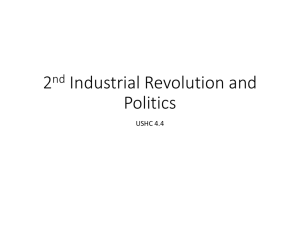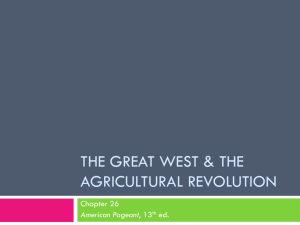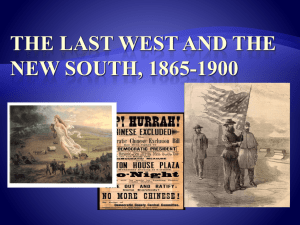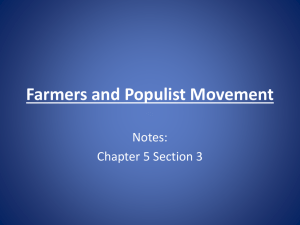Unit 5 Notes Organizer: C. Rebuilding a Nation (Expansion
advertisement
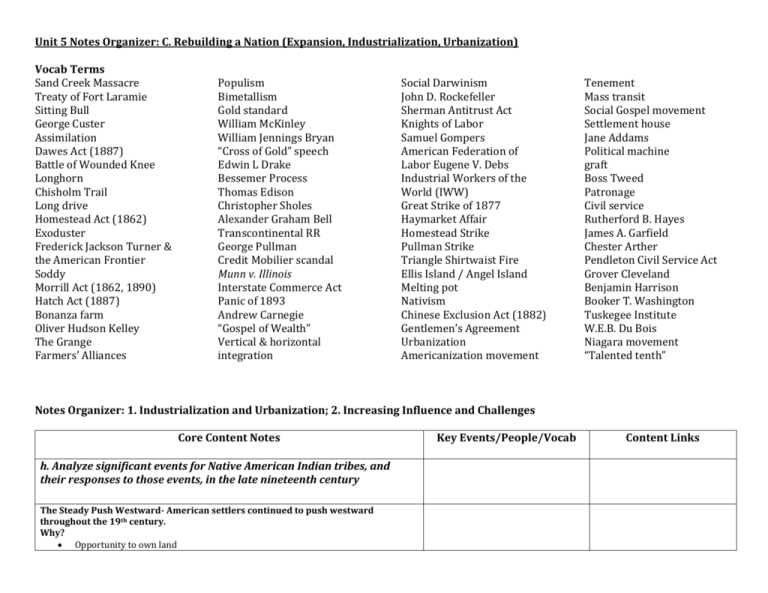
Unit 5 Notes Organizer: C. Rebuilding a Nation (Expansion, Industrialization, Urbanization) Vocab Terms Sand Creek Massacre Treaty of Fort Laramie Sitting Bull George Custer Assimilation Dawes Act (1887) Battle of Wounded Knee Longhorn Chisholm Trail Long drive Homestead Act (1862) Exoduster Frederick Jackson Turner & the American Frontier Soddy Morrill Act (1862, 1890) Hatch Act (1887) Bonanza farm Oliver Hudson Kelley The Grange Farmers’ Alliances Populism Bimetallism Gold standard William McKinley William Jennings Bryan “Cross of Gold” speech Edwin L Drake Bessemer Process Thomas Edison Christopher Sholes Alexander Graham Bell Transcontinental RR George Pullman Credit Mobilier scandal Munn v. Illinois Interstate Commerce Act Panic of 1893 Andrew Carnegie “Gospel of Wealth” Vertical & horizontal integration Social Darwinism John D. Rockefeller Sherman Antitrust Act Knights of Labor Samuel Gompers American Federation of Labor Eugene V. Debs Industrial Workers of the World (IWW) Great Strike of 1877 Haymarket Affair Homestead Strike Pullman Strike Triangle Shirtwaist Fire Ellis Island / Angel Island Melting pot Nativism Chinese Exclusion Act (1882) Gentlemen’s Agreement Urbanization Americanization movement Tenement Mass transit Social Gospel movement Settlement house Jane Addams Political machine graft Boss Tweed Patronage Civil service Rutherford B. Hayes James A. Garfield Chester Arther Pendleton Civil Service Act Grover Cleveland Benjamin Harrison Booker T. Washington Tuskegee Institute W.E.B. Du Bois Niagara movement “Talented tenth” Notes Organizer: 1. Industrialization and Urbanization; 2. Increasing Influence and Challenges Core Content Notes h. Analyze significant events for Native American Indian tribes, and their responses to those events, in the late nineteenth century The Steady Push Westward- American settlers continued to push westward throughout the 19th century. Why? Opportunity to own land Key Events/People/Vocab Content Links The possibility to strike it rich following gold discoveries in California (1848), Colorado (1858), Black Hills, South Dakota (1872) Other economic opportunities: Buffalo hunts, cattle, railroads, and of course, farming Government programs to encourage settlement and cheap land As settlers pushed further west, government policy toward Native Americans changed, and violent clashes increased. 1834: Indian Intercourse Act Declared the entire Great Plains as an enormous reservation set aside for Native American tribes 1851 & 1853: Treaties of Fort Laramie and Fort Atkinson, respectively Federal Government signed treaties with individual tribes, setting specific boundaries for each ***marks the beginnings of the reservation system in the West Most Indian tribes spurned the treaties and continued to hunt on traditional lands, leading to deadly clashes with settlers 1864: Sand Creek Massacre Col. J.M. Chivington’s militia massacred 250 Cheyenne and Arapaho warriors, and 150 women and children who were shot in cold blood while praying for mercy 1866: Death on the Bozeman Trail The Sioux indian tribe unsuccessfully appealed to the US government, hoping to stop the construction of the Bozeman Trail which ran through Sioux hunting grounds to the Montana gold fields A Sioux war party, led by Crazy Horse, ambushed Captain William J. Fetterman and eighty-one soldiers in Wyoming’s Big Horn mountains The Indians left no survivors, mutilating the corpses Native Americans called this the Battle fo the Hundred Slain; whites called it the Fetterman Massacre Treaty of Fort Laramie (1868)- Government agreed to stop construction of the Bozeman Trail, in return, the Sioux agreed to live on a reservation along the Missouri River. Many Sioux leaders, including Sitting Bull, NEVER SIGNED the treaty 1874-1875: Red River Wars Following six years of raiding by Kiowa and Comanche warriors, The U.S. Army responded by herding friendly tribes onto reservations and opening fire on all others Led by Gen. Phillip Sheridan, the U.S. army crushed indian resistance on the southern plains 1874: Black Hills Gold Rush Col. George Custer announced the discovery of gold in Wyoming’s Black Hills Sioux appealed to US government to respect their lands…to no avail 1876: The Battle of Little Big Horn…Custer’s Last Stand The Sioux and Cheyenne held a sun dance in early June Gen. George Custer and the 7th Cavalry were sent to end the sun dance and force the Sioux and Cheyenne back onto their reservation Led by Crazy Horse, Gall, and Sitting Bull, the indian alliance crushed Custer and his men in two days of fighting The victory was short lived, by late 1876 the Sioux were beaten Sitting Bull eventually surrendered in 1881 and later traveled with Buffalo Bill’s Wild West Show ***Despite Custer’s defeat, he became a national hero as Wild West shows portrayed him and his troops fighting courageously against a much larger enemy force. 1881: Helen Hunt Jackson publishes A Century of Dishonor Book exposed the government’s broken promises and mistreatment of Native Americans Assimilation: a plan under which Native Americans would give up their beliefs and way of life and take on white culture Schools were set up to teacher Indian children white American culture ***Quotes from the Carlisle Indian Industrial School: “We all wore white man’s clothes and ate white man’s food” 1887: Congress passes the Dawes Act Broke up the tribal reservations and apportioned the land to individual Native Americans- 160 acres to heads of households and 80 acres to each unmarried adult The remaining land would be sold to settlers, and the income was to be used to Native Americans to buy farm implements…Native Americans received NO MONEY from the sale of these lands ***The Dawes Act represented a MAJOR CHANGE in US policy toward American Indians after the Civil War. 1890: The Battle of Wounded Knee Dec. 28, 1890, the 7th Cavalry rounded up approximately 350 starving and freezing Sioux- took them to a camp near Wounded Knee Creek, South Dakota Dec. 29th- soldiers demanded the Sioux give up their weapons, a shot was fired… The soldiers opened fire on the Indians with cannon and machine guns Over 300 unarmed Sioux were killed ***the massacre at Wounded Knee represented the culmination of the U.S. military operations against Native Americans g. Identify and evaluate the influences on the development of the American West ***“The great work, commenced during the Administration of Lincoln, in the middle of a great rebellion, is completed under that of Grant, who conquered the peace” The quote above was a telegraph message sent from Promontory Summit, Utah, marking the completion of the first transcontinental railroad. The railroads helped spur the growth of the American west Cattle Becomes BIG Business Vaqueros were Mexican ranchers who taught Americans how to handle large herds on the open range Longhorns- sturdy breed of cattle accustomed to the dry grasslands of southern plains Growing Demand for Beef- After the Civil War, demand for beef skyrocketed, partially because of rapidly growing cities. The Chicago Union Stockyards were the main thoroughfare for ranchers to get cattle from the plains to eastern markets The Chisholm Trail quickly became the primary route of the long drive, the overland transport of cattle from the range of Texas to the railroads in Abilene, KS. By 1868, more than 75,000 head of cattle was shipped to Chicago and then to eastern markets through Abilene ***Dodge City, KS was another famous ending point of cattle drives and the home of legendary frontier figures Wyatt Earp, Bat Masterson, and Doc Holliday The End of the Open Range- As quickly as the herd had grown, the cattle frontier came to an end. Why? Overgrazing of pasture land Alternating patterns of dry summers and harsh winters between 1883-1887 wiped out entire herds Ranchers turned to smaller herds of high-yield stock Joseph Glidden invented Settlers Move Westward to Farm- It took over 250 years, from the first settlement at Jamestown until 1870, to turn 400 million acres of forest and prairies in to flourishing farmland. Settling the second 400million acres took only 30 years, from 1870-1900. How was this possible? Federal Land policy Completion of the transcontinental railroad lines Railroads Open the West From 1850-1871, the federal gov. made huge land grants to the railroads- 170 million acres, for laying track in the West Union Pacific and Central Pacific received 10 square miles of land for every mile of track laid in a state, and 20 square miles for every mile of land laid in a territory The two railroads, the Central Pacific moving east from Sacramento, CA, and the Union Pacific moving west from Omaha, NE, began laying the transcontinental line Civil War vets, Irish, Chinese, & Mexican immigrants, and African Americans did most of the backbreaking work May 10, 1869- the first transcontinental line was finished Within 15 years, 5 transcontinental lines stitched the country together RRs sold some land to farmers, some sent agent to Europe to recruit buyers By 1880, 44% of Nebraska settlers and 70% of settlers in Minnesota and Wisconsin were immigrants Government Support for Settlement- ***In 1862, Congress passed the Homestead Act Offered 160 acres of land free to any citizen or intended citizen willing to improve the land within 5 years By 1900, up to 600,000 families took advantage of this offer Exodusters- African Americans who left the South after the Civil War and went to Kansas to seek land and opportunity Oklahoma Land Giveaway- in 1889, settlers claimed more than 2 million acres of land in a massive land rush (race) Some took the land before the government officially declared it open. Oklahoma would become known as the “Sooner State” The Closing of the Frontier- In 1890, the Census Bureau declared that the country no longer had a continuous frontier- the frontier no longer existed Frederick Jackson Turner’s “Frontier Thesis”- In 1893, a young historian named Frederick Jackson Turner gave a speech at the Chicago World Fair in which he claimed that there no longer existed an American frontier, that all the land had been settled. Argued that the process of moving from the East to the West shaped the American character. By moving from settled to unsettled land, Americans shed the ''European'' part of themselves, and became American in the process. ***Some historians have proposed an alternative to Turner’s thesis- arguing that the city, not the Western frontier, was the “safety valve” for ambitious and enterprising Americans Meeting the Challenges of the Plains- Despite facing extreme hardships such as droughts, floods, fires, blizzards, locust plagues, and others- the percentage of Americans living west of the Mississippi River grew from 1% in 1850 to almost 30% by 1900. Dugouts and Soddies- Since trees were scarce, most settlers made their homes from the land itself Dugouts- built into a hill Soddy- built by stacking blocks of prairie sod. Were warm in winter, cool in the summer…but also were havens for snakes, bugs, and leaks. Women on the Frontier- Women led lonely, isolated lives with their husbands/families on the frontier Worked hand in hand with men in the field Sheared sheep to make wool clothes Hauled water from wells Canned fruits and veggies Became skilled in doctoring Also contributed to schools and churches to build communities Technology supports Farmers- New technologies helped farmers turn the prairie into an agricultural factory 1837- John Deere’s steel plow 1847- Cyrus McCormick’s reaper 1841- Grain drill to plant seeds 1878- Corn/grain binder 1880s- Combine reaper-thresher ***These inventions increased production and made more grain available for a wider market Agricultural Education- The federal government supported farmers by financing agricultural education Morrill Act (1862 & 1890)- gave federal land to states to help finance agricultural colleges Hatch Act (1887)- established agricultural experiment stations to inform farmers of new developments ***These two pieces of legislation helped spawn over one hundred colleges and universities Farmers in Debt- Farmers often had to borrow money to purchase expensive machinery When wheat prices were high- they could pay off debt; when wheat prices fellfarmers raised more crops to make ends meet (This NEVER works) This gave rise to bonanza farms- huge single-crop farms, often as large as 50,000 acres, created by railroad companies and investors Drought during the years between 1885-1890 caused many bonanza farms to go bankrupt Farmers and the problem of the railroads- with little or no competition, railroads took advantage of western farmers, especially the small privately owned farm Charged western farmers higher fees than those in the east Sometimes charged more for short-hauls than for longer hauls ***many farmers found themselves growing more, on more land, yet becoming further and further in debt. (2)a. Identify and explain significant issues and components of the Populist movement and their impacts Farmers Unite to Address Common Problems- In the late 1800’s, many farmers were trapped in a vicious economic cycle. Crop prices falling Famers went further in debt buying more land to produce more crops Fertile farm land was becoming scarce Banks foreclosed on mortgages of farmers who could pay their loans Railroads took advantage of farmers by charging excessive prices for shipping and storage Economic Distress- Economic policy during and after the Civil War contributed to problems for farmers and the nation as a whole $500 million in “Greenbacks” (paper money) were printed during the Civil War, couldn’t be exchanged for gold or silver worth less than hard money After the war, gov. began to take greenbacks out of circulation- increasing the value of greenbacks left in circulation This meant farmers had to pay back loans with dollars that were worth more than the dollars they had borrowed, at the same time that they were getting less and less money from their crop sales- OUCH! Farmers pushed the gov. to issue more money into circulation The Bland-Allison Act of 1878 required the gov. to buy and coin $2-4million of silver each month, but it wasn’t enough to raise prices to level farmers wanted Problems with the Railroads- Farmers were forced to pay outrageously high prices to ship and store grain. Why? Lack of competition Railroads made secret agreements with middlemen- grain brokers and merchantsthat allowed railroads to control grain storage prices and influence market prices of crops ^***The increasing domination of markets by a few powerful buyers contributed to declining crop prices and increasing rural poverty in the 1890s The Vicious Cycle of Debt- Many farmers mortgaged their farms for credit to buy seed and supplies. Many suppliers charged high rates of interest, charged higher prices for items bought on credit than with cash ***Farmers got caught in a cycle of falling prices and rising debt. IT WAS TIME FOR REFORM! The Farmers’ Alliances- To push effectively for reform, farmers needed to organize 1867- Oliver Hudson Kelley started the Patrons of Husbandry, which became known as The Grange Original purpose was a social and educational outlet for isolated farmers By 1870s, members spent most time & energy fighting RRs Tough members how to organize, set up cooperatives, and to sponsor state legislation to regulate RRs The Grange gave rise to other orgs., such as the Farmers Alliances, who included others who sympathized with farmers o Educated people on how to get lower interest rates on loans o Pushed for gov. control over RRs and banks o Membership quickly grew to over 4 million, mostly in the West and South The Grange was successful at the state and local level in gaining passage of “Granger laws” o 1871: Illinois authorized a commission “to establish maximum freight and passenger rates and prohibit discrimination.” States right to regulate RRs to benefit farmers and consumers was upheld in the Supreme Court case Munn v, Illinois (a short lived decision that would be overturned in 1886) Granges convinced many state legislators in the West, Midwest, and South to pass similar laws o Public outrage following the 1886 Supreme Court ruling that said a state could NOT set rates on interstate commerce (RR traffic) prompted Congress to pass the Interstate Commerce Act in 1887 o Established the right of the federal gov. to supervise RR activities and establish a five-member Interstate Commerce Commission (ICC) o o o The Rise and Fall of Populism- the alliances realized they would need to build political power to make far-reaching changes. The Populist Party, or People’s Party was founded in 1892 Became the political party of Populism- the movement of the people Announced its platform to lift the burden of debt from farmers and give the people a greater voice in government The Populist Party Platform Increase in the money supply (through bi-metallism) to increase prices received for goods and services A graduated income tax Election of senators by popular vote of a state’s citizens Single-term for president and VP Secret ballot to end vote fraud An 8-hour work day Restrictions on immigration ***the Populist platform attracted farmers and laborers to the party o Populist presidential nominee won nearly 10% of vote in 1892 o In the West, the Populist Party elected 5 senators, 3 governors, and 1,500 state representatives ***Populist Party leaders opposed voter disenfranchisement in southern states o ***the sought to unite all people against wealthy and powerful interests The Panic of 1893- While farmers were overextended with debt, the rest of the economy fell on hard times as well The Philadelphia, Reading Railroad, Erie, Northern Pacific, Union Pacific, and Santa Fe RRs all went bankrupt, largely due to overspeculation & expansion The government’s gold supply was very low, partly because of the Bland-Allison Act People panicked and traded paper money for gold On Wall St., stock prices plummeted The price of silver plunged leading to silver mines closing ***by the end of the year, over 15,000 businesses and 500 banks had collapsed o investments declined, consumer purchases, prices and wages fell ***Panic deepened into depression o 3 million lost jobs, a fifth of the workforce unemployed o Many farmers suffered Silver or Gold? The Election of 1896- As the election of 1896 neared, the two major political parties struggled between different regions and economic interests Business owners & bankers of the industrial Northeast leaned Republican; farmers and laborers of the agrarian South & West favored Democrats & Populists The central issue of the campaign was which metal would be the basis of the nation’s monetary policy o “Silverites” favored bimetallism- where the gov. would exchange either gold or silver for paper currency= more money in circulation This would cause inflation Prices rise Value of money decreases More people have money o President Grover Cleveland and the “gold bugs” favored the gold standard- which backed dollars solely with gold= less money in circulation Loans would be repaid with stable money This would cause deflation Prices fall Value of money increases Fewer people have money The Populist Party called for bimetallism, but couldn’t decide whether to join with a sympathetic major party or nominate their own candidate for president Republicans nominated William McKinley The Democrats came out for bimetallism, and nominated Nebraska congressman William Jennings Bryan following his passionate “Cross of Gold” speech o “Having behind us the producing masses of this nation and the world, supported by the commercial interests, the laboring interests, and the toilers everywhere, we will answer their demand for a gold standard by o saying to them: You shall not press down upon the brow of labor this crown of thorns, you shall not crucify mankind upon a cross of gold.” ***The Populists endorsed William Jennings Bryan, and nominated their own candidate, Thomas Watson, for vice-president The End of Populism- While Bryan worked tirelessly to win election, he faced many obstacles His silverite stance pushed gold-bug Democrats to nominate their own candidate, splitting the parties votes His monetary position also weakened support in cities, where consumers feared inflation would make goods more expensive Bryan could not compete with the funding of McKinley McKinley handily won the election, carrying the urban East and industrial MidWest Bryan’s defeat caused Populism to collapse, but the populist movement left two powerful legacies 1. A message that the down-trodden could organize and have political impact 2. Much of the Populist platform would be enacted in the 20th century The graduated income tax via the 16th Amendment Popular election of senators via the 17th Amendment The secret ballot An 8-hour work day Restrictions on immigration a. Evaluate the impact of new inventions and technologies of the late nineteenth century Between 1865 (after the Civil War) and 1920, America went from being a largely agricultural nation to becoming the leading industrial power in the world! Factors that contributed to this industrial boom included: Abundant natural resources Government support for business A growing urban population that provided cheap labor and markets for new products Natural Resources Provide the Fuel for the Furnace of Industrialization- oil, iron, and coal played an integral part in America’s industrial growth Oil-In 1859, Edwin L. Drake successfully used a steam engine to drill for oil near Titusvill, PA. This breakthrough started an oil boom that spread southwest through Ohio, Kentucky, Illinois, Indiana, and later into Texas Petroleum-refining became big industries in Cleveland and Pittsburg as entrepreneurs rushed to turn oil into kerosene Iron- Iron ore was plentiful in America, and in 1887, prospectors discovered iron ore deposits more than 100 miles long and 3 miles wide in the Mesabi Range of Minn. While iron is dense, it is also soft and tends to break and rust Iron had been turned into steel for hundreds of years, but not easily and not in great quantity Around 1850, British manufacturer Henry Bessemer developed a cheap and efficient way to remove carbon from iron to produce a lighter, more flexible, and rust-resistant steel. The Bessemer process changed EVERYTHING! o ***Revolutionized the steel industry o ***Accelerated steel production while dramatically reducing costs and the need for human labor ***Revolutionary changes in steel production and the growth of railroads had the greatest impact on the development of the United States’ industrial infrastructure in the late nineteenth century Coal- Production of coal skyrocketed from 33 million tons in 1870 to more than 250 million tons in 1900! Heated the kilns that produced steel Fueled the railroads that delivered iron ore to steel mills Fueled the trains that brought finished manufactured goods to urban markets Was burned to create electricity in Edison and Westinghouse’s electric generators New Uses for Steel- While the railroads became the biggest customers for steel, inventors soon found new uses for it. ***Joseph Glidden’s barbed wire ended the open range and effectively ended the need for long cattle drives Bridges such as the Brooklyn Bridge, completed in 1883, spanned distances unheard of in the past William Le Baron Jenney designed the first skyscraper, allowing cities to grow up, as well as out The elevator would allow skyscrapers to reach the clouds Inventions Promote Change-Harnessing America’s natural resources and their own ingenuity, inventors changed the way people lived and worked Thomas Edison- Earning over 1,000 patents, Edison became one of the most important inventors in American history Established the world’s first research and development (R&D) lab in Menlo Park, New Jersey in 1876 Perfected the incandescent lightbulb o ***Edison also invented an entire system for producing and distributing electricity, which was necessary for the lightbulb’s success. o ***Edison’s bulb replaced the dirty and dangerous gaslight o ***It also had a positive impact on literacy rates and the use of public libraries George Westinghouse- Innovations in electricity He and Edison made electricity safer and less expensive Alexander Graham Bell- In 1876, Bell and Thomas Watson invented the telephone Opened the way for worldwide communications network Christopher Sholes- Invented the typewriter in 1867 Along with the telephone, the typewriter created new jobs for women, helping them account for nearly 40% of the clerical workforce by 1910 Negative Impacts of Industrialization Dehumanized the workforce- many laborers felt mechanization reduced the worth of workers as humans Positive Impacts of Industrialization Freed some factory workers from backbreaking labor, improved workers’ standard of living Led to a reduction of the workweek of 10 hours by 1890 Workers gained power in the marketplace as consumers The country’s expanding city populations provided the market for new inventions and products ***Installation of sewage disposal systems improved health for people in cities b. Identify and evaluate the influences on business and industry in the late nineteenth and early twentieth centuries c. Identify labor and workforce issues of the late nineteenth century, including perspectives of owners/managers and Social Darwinists d. Explain the challenges and contributions of immigrants of the late nineteenth century e. Explain the causes and impact of urbanization in the late nineteenth century f. Compare and contrast the experiences of African Americans in various U.S. regions in the late nineteenth century
